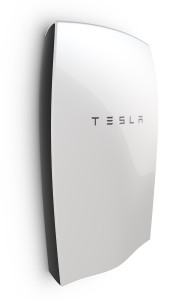Can this new home battery be a game changer for sustainable energy?
In April 2015, Elon Musk’s Tesla revealed their latest project, which has the potential to transform the way we store and use energy in our homes. The Tesla Powerwall is a sleek home battery that is charged from electricity generated from solar panels, or from the electric utility when electricity rates are lower. It then stores the energy for use during the evening and night or for when electricity rates are high.
When the Powerwall was announced, Musk explained that generating, and then storing, energy from the sun is a very attainable solution for shifting the world towards sustainable energy and that the Powerwall may have the potential to start this shift. The Powerwall solves two major problems with solar energy:
- Solar collectors could take up large amounts of productive space to generate sufficient solar energy to meet the energy needs of all of the U.S.. However, considering the amount of space on existing rooftops alone, the possibility of generating all of our energy from solar is quite feasible provided there is a cost-effective means for storing the locally captured energy without overburdening the grid. The Powerwall could provide that storage.
- The fact that the sun does not shine at night means that we must find a way to store the solar energy that is created during the day, so we can use it at night. The Powerwall can be used to provide stored electricity when the sun is not shining.
Essentially, energy storage is a missing link that is needed to create a sustainable energy future from roof top solar installations.
While the Powerwall, in the right application, has the ability to power a home on solar power alone, it also has two other benefits. First, for Powerwall users that are tied to the grid, they can avoid paying peak rates for electricity. The Powerwall can store electricity when rates are low and power the home when rates are high. Second, the Powerwall creates a safe and secure energy backup in the case of a power outage, great for homes in areas with severe storms or prone to grid failure.
The Powerwall has a sleek, low-profile design that allows it to be easily mounted on any home’s wall, scrapping the need for a battery storage room that takes up a lot of space. It comes with an inverter and the wiring needed for solar panel integration, in one neat package, designed to work with residential solar panels right out of the box.
The lithium-ion Powerwall outputs 2.0 kW continuous with a 3.3 kW peak. At 220 pounds, it certainly isn’t a lightweight battery, but can easily be installed by a trained electrician. Tesla Powerwalls are available for order on the Tesla website, and the company plans to ship the product sometime this summer. Current pricing is $3,500 (not including installation costs).
We think the Powerwall could be a game changer in the movement towards a sustainable carbon-free energy future, provided its price comes down and storage capacity increases over the next few years.
We’ve pre-ordered a Powerwall to test it out and see how it works in our Positive Energy Home here in Bend, Oregon. We are excited to see how it works out. Stay tuned for updates!
What do you think about the Tesla Powerwall? Do you have plans to order or install one in your home? We’d love to hear from you. Please feel free to leave a comment below or send us a direct email with your thoughts.

